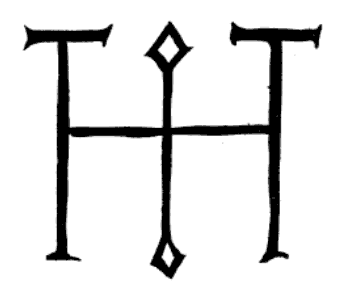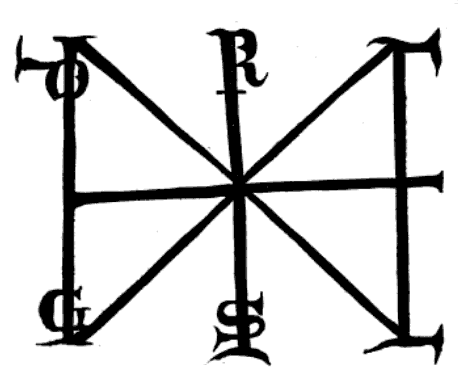Signum manus on:
[Wikipedia]
[Google]
[Amazon]



 ''Signum manus'' (transl. ''sign of the hand'', sometimes also known as ''Chrismon'') refers to the medieval European practice of signing a document or charter with a special type of
''Signum manus'' (transl. ''sign of the hand'', sometimes also known as ''Chrismon'') refers to the medieval European practice of signing a document or charter with a special type of
157
ndash;202. *Ersch ''et al''., Volume 1, Issue 29 of ''Allgemeine Encyklopädie der Wissenschaften und Künste'', 1837
303
ndash;307. *Johann Christoph Gatterer, ''Elementa artis diplomaticae universalis'' (1765)
145
ndash;149 ( '' Abriß der Diplomatik'' 1798,
64
ndash;67). * Karl Friedrich Stumpf-Brentano, ''Die Wirzburger Immunitaet-Urkunden des X und XI Jahrhunderts'' vol. 1 (1874),
13
ndash;17. {{Christian crosses Signature Monograms Cross symbols Merovingian art Carolingian art


 ''Signum manus'' (transl. ''sign of the hand'', sometimes also known as ''Chrismon'') refers to the medieval European practice of signing a document or charter with a special type of
''Signum manus'' (transl. ''sign of the hand'', sometimes also known as ''Chrismon'') refers to the medieval European practice of signing a document or charter with a special type of monogram
A monogram is a motif (visual arts), motif made by overlapping or combining two or more letters or other graphemes to form one symbol. Monograms are often made by combining the initials of an individual or a company, used as recognizable symbo ...
or royal cypher
In modern heraldry, a royal cypher is a monogram or monogram-like device of a country's reigning Monarch, sovereign, typically consisting of the initials of the monarch's name and title, sometimes interwoven and often surmounted by a Crown (heral ...
. The practice is documented from at least the Merovingian period (ca. 5th century) until the 14th century
The 14th century lasted from 1 January 1301 (represented by the Roman numerals MCCCI) to 31 December 1400 (MCD). It is estimated that the century witnessed the death of more than 45 million lives from political and natural disasters in both Euro ...
in the Frankish Empire
The Carolingian Empire (800–887) was a Frankish-dominated empire in Western and Central Europe during the Early Middle Ages. It was ruled by the Carolingian dynasty, which had ruled as kings of the Franks since 751 and as kings of the Lomba ...
and its successors.
History
The term ''Chrismon'' was introduced inNeo-Latin
Neo-LatinSidwell, Keith ''Classical Latin-Medieval Latin-Neo Latin'' in ; others, throughout. (also known as New Latin and Modern Latin) is the style of written Latin used in original literary, scholarly, and scientific works, first in Italy d ...
specifically as a term for the Chi Rho
The Chi Rho (☧, English pronunciation ; also known as ''chrismon'') is one of the earliest forms of the Christogram, formed by superimposing the first two (capital) letters—chi (letter), chi and rho (ΧΡ)—of the Greek (Romanization of ...
monogram. As this symbol was used in Merovingian documents at the starting point of what would diversify into the tradition of "cross-signatures", German scholarship of the 18th century extended use of the term ''Chrismon'' to the entire field. In medievalist paleography
Palaeography (American and British English spelling differences#ae and oe, UK) or paleography (American and British English spelling differences#ae and oe, US) (ultimately from , , 'old', and , , 'to write') is the study and academic disciplin ...
and ''Diplomatik'' (''ars diplomaticae'', i.e. the study of documents or charters), the study of these signatures or sigils was known as ''Chrismologia'' or ''Chrismenlehre'', while the study of cross variants was known as ''Staurologia''.
''Chrismon'' in this context may refer to the Merovingian period abbreviation ''I. C. N.'' for ''in Christi nomine'', later (in the Carolingian period) also ''I. C.'' for ''in Christo'', and still later (in the high medieval period) just ''C.'' for ''Christus''.
A cross symbol was often drawn as an invocation at the beginning of documents in the early medieval West. At the end of documents, commissioners or witnesses would sign with a ''signum manus'', often also in the form of a simple cross. This practice is widespread in Merovingian documents of the 7th and 8th centuries. A related development is the widespread use of the cross symbol on the obverse side of early medieval coins, interpreted as the ''signum manus'' of the moneyer.
The tradition of minting coins with the monogram of the ruling monarch on the obverse side originates in the 5th century, both in Byzantium and in Rome. This tradition was continued in the 6th century by Germanic kings, including the Merovingians. These early designs were ''box'' monograms. The first ''cruciform'' monogram was used by Justinian I
Justinian I (, ; 48214 November 565), also known as Justinian the Great, was Roman emperor from 527 to 565.
His reign was marked by the ambitious but only partly realized ''renovatio imperii'', or "restoration of the Empire". This ambition was ...
in the 560s. Tiberius III
Tiberius III (), born Apsimar (; ), was Byzantine emperor from 698 to 705. Little is known about his early life, other than that he was a , a mid-level commander, who served in the Cibyrrhaeot Theme. In 696, Tiberius was part of an army sent b ...
used a cruciform monogram with the letters ''R, M'' for Rome and ''T, B'' for Tiberius; Pope Gregory III
Pope Gregory III (; died 28 November 741) was the bishop of Rome from 11 February 731 to his death on 28 November 741. His pontificate, like that of his predecessor, was disturbed by Byzantine iconoclasm and the advance of the Lombards, in which ...
used the letters ''G, R, E, O''.
The earliest surviving Merovingian royal charters, dating to the 7th century, have the box monograms of Chlothar II
Chlothar II, sometimes called "the Young" ( French: le Jeune), (May/June 584 – 18 October 629) was king of the Franks, ruling Neustria (584–629), Burgundy (613–629) and Austrasia (613–623).
The son of Chilperic I and his third wife, Fred ...
and Clovis II. Later in the 7th century, the use of royal monograms was abandoned entirely by the Merovingian kings; instead, royal wax seals were first attached to the documents, and the kings would sign their name in full.
The ''signum manus'' in the form of a modified cross symbol first appears in charters of both Frankish Gaul and Anglo-Saxon England in the late 7th and early 8th century. Charlemagne
Charlemagne ( ; 2 April 748 – 28 January 814) was List of Frankish kings, King of the Franks from 768, List of kings of the Lombards, King of the Lombards from 774, and Holy Roman Emperor, Emperor of what is now known as the Carolingian ...
first used his cruciform monogram, likely inspired by the earlier papal monograms, in 769, and he would continue to use it for the rest of his reign. The monogram spells ''KAROLVS'', with the
consonants ''K, R, L, S'' at the ends of the cross-arms, and the vowels ''A, O, V'' displayed in ligature at the center.
Louis the Pious
Louis the Pious (; ; ; 16 April 778 – 20 June 840), also called the Fair and the Debonaire, was King of the Franks and Holy Roman Emperor, co-emperor with his father, Charlemagne, from 813. He was also King of Aquitaine from 781. As the only ...
abandoned the cross monogram, using again a H-type or box monogram.Garipzanov (2008:182)
See also
*Christogram
A Christogram () is a monogram or combination of letters that forms an abbreviation for the name of Jesus Christ, traditionally used as a Christian symbolism, religious symbol within the Christian Church.
One of the oldest Christograms is the C ...
* Rota (papal signature)
*Royal cypher
In modern heraldry, a royal cypher is a monogram or monogram-like device of a country's reigning Monarch, sovereign, typically consisting of the initials of the monarch's name and title, sometimes interwoven and often surmounted by a Crown (heral ...
*Tughra
A tughra (; ) is a calligraphy, calligraphic monogram, Seal (emblem), seal or signature of a sultan that was affixed to all official documents and correspondence. Inspired by the Tamga, tamgha, it was also carved on his seal and stamped on the co ...
References
*Ildar H. Garipzanov, Chapter 4 in ''The Symbolic Language of Royal Authority in the Carolingian World (c.751-877)'' (2008)157
ndash;202. *Ersch ''et al''., Volume 1, Issue 29 of ''Allgemeine Encyklopädie der Wissenschaften und Künste'', 1837
303
ndash;307. *Johann Christoph Gatterer, ''Elementa artis diplomaticae universalis'' (1765)
145
ndash;149 ( '' Abriß der Diplomatik'' 1798,
64
ndash;67). * Karl Friedrich Stumpf-Brentano, ''Die Wirzburger Immunitaet-Urkunden des X und XI Jahrhunderts'' vol. 1 (1874),
13
ndash;17. {{Christian crosses Signature Monograms Cross symbols Merovingian art Carolingian art